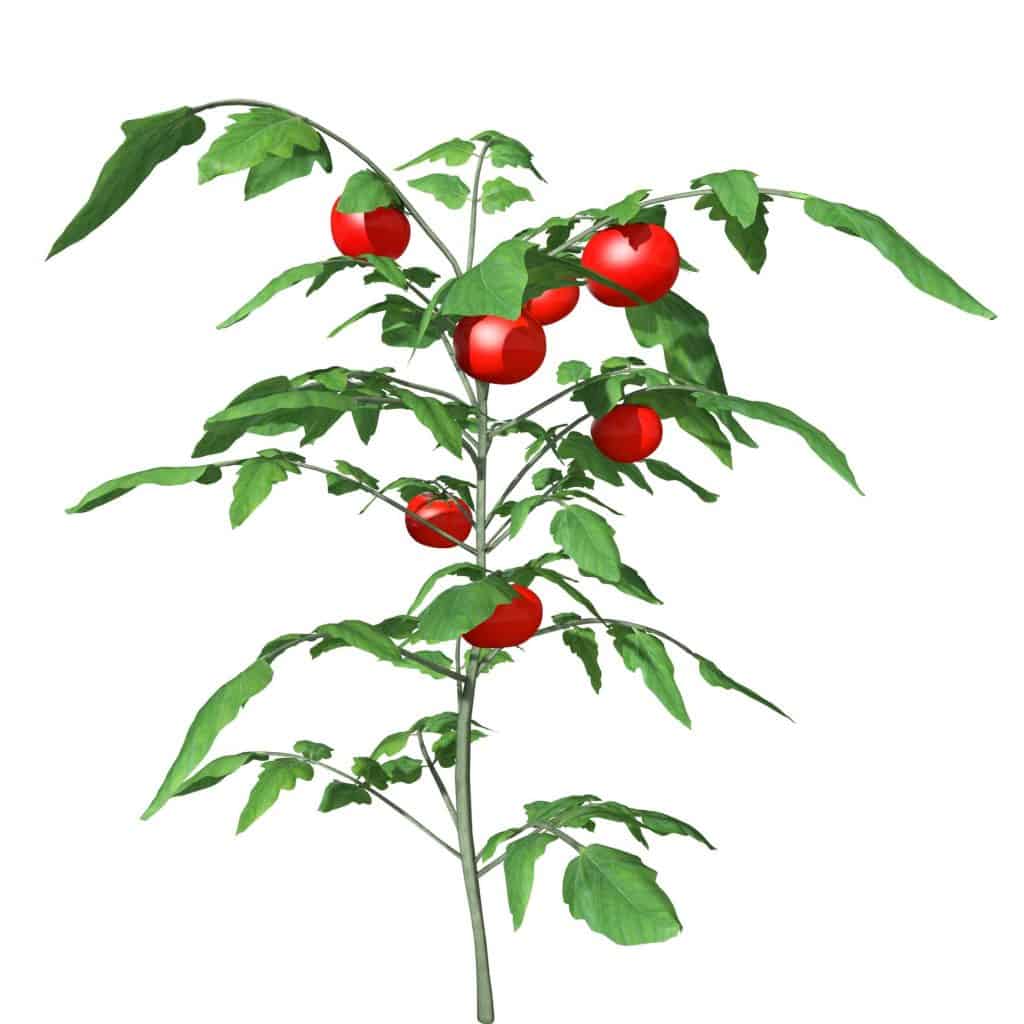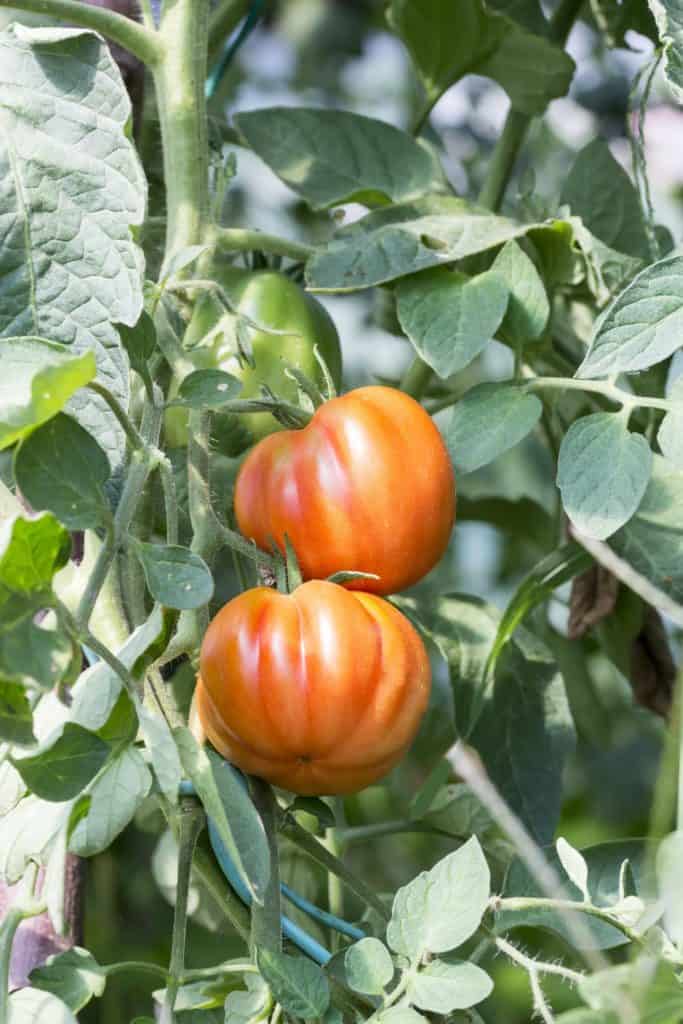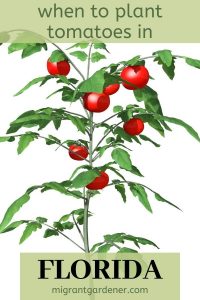Farmers in Florida make Florida, commercially speaking, the #1 fresh tomato production state. In 2018, sales of tomatoes grown in Florida amounted to just over $344 million, making it the second-most money-producing fruit after oranges ($701,855,000 in 2018).
And yet, gardeners in Florida often struggle to grow tomatoes.
It makes sense, then, for the home gardener to make some alterations to basic tomato-growing practices. This way, the chances of an increase in yield are higher.
Florida farmers tend to grow determinate tomato varieties. Thus, choose determinate tomato varieties yourself and make sure that the varieties you select have resistance to the main diseases.
The majority of gardeners in Florida, in the US, and elsewhere generally grow indeterminate varieties. But, as mentioned, Florida farmers prefer determinate types.
What’s the difference between the two? What’s the difference between determinate tomato plant varieties and indeterminate tomato varieties?
Determinate are more compact. Most of the crop is produced at one time. Indeterminate varieties continually produce fruit until fall frosts arrive.
Typically, with determinate tomato varieties, you’ll be able to harvest the entire crop in three to five pickings. Then discard the plant.

It’s all about good variety selection
One of the key reasons that home tomato growers find it difficult to grow tomatoes in Florida is down to variety selection.
Even the most popular of indeterminate tomato varieties are, to some extent, lacking in resistance to bacterial wilt and tomato spotted wilt virus (TSWV).
Both diseases are devastating to tomato crops in Florida – both at home and in a commercial sense.
So which tomato varieties should you choose?
Tomatoes With Medium to High Disease Resistance Suitable for Growing in Florida
Note that this list is in no way exhaustive. There are many other tomato varieties that offer good disease resistance. Nevertheless, this list comprises some of the best tomato varieties in terms of disease resistance.
Information c/o Integrated Pest Management Department, University of Florida.

What do the abbreviations mean?
ASC – Alternaria stem canker – Alternaria alternata f.sp. lycopersici
BSK – Bacterial speck – Pseudomonas syringae pv tomato race 0
CLS – Cladosporium leaf mold – Cladosporium fulvum
F-R 1,2,3 – Fusarium wilt Race 1, 2, 3 – Fusarium oxysporum f.sp. lycopersici races 1, 2, 3
FCR – Fusarium crown rot – Fusarium oxysporum f.sp. radicis-lycopersici
N – Root knot nematode – Meloidogyne arenaria, M. incognita & M. javanica
Stemph – Gray leaf spot – Stemphylium solani
TMV – Tobacco mosaic virus
ToMV – Tomato mosaic virus
TSWV – Tomato spotted wilt virus
TYLCV – Tomato yellow leaf curl virus
V1 – Verticillium wilt – Verticillium albo-atrom, Verticillium dahliae race 1
R – Resistant
IR – Intermediate Resistance
T – Tolerant
Round Tomatoes With Medium to High Disease Resistance Suitable for Growing in Florida
Amelia – Main season. Resistance to F-R 1, 2, 3, root-knot nematode, V1, intermediate resistance to Stemph and TSWV. Vigorous determinate plant with an excellent leaf canopy ideal for green and vine ripe harvest, crack tolerant skin. Firm, aromatic fruit. Harris Moran.
Bella Rosa – Resistant to TSWV. Determinate type. Heat tolerant. Produces firm, uniformly shaped fruit. Sakata.
Crista – 74 days, Resistance to, F-R 1, 2, 3, N, intermediate TSWV, V1. Large, deep globe fruit, tall robust plants. Does best with high fertility and pruned to three leaders. Good flavor, color, and shelf-life. Harris Moran.
Crown Jewel – Resistance to ASC, FCR, F-R 1, 2, Stemph and V1. Determinate with medium-tall bush. Uniform fruit has a deep oblate shape and good firmness and quality with uniformly-colored shoulders and jointed pedicles.
Seminis.
Linda – Main season. Resistance to ASC, F-R1, 2, Stemph, V1. Large, round fruit with excellent firmness, sturdy, determinate bush with good cover. Competitive yields of large, smooth, uniform shouldered fruit with a small blossom end scar. Sakata.
Phoenix – Early midseason. Resistance to ASC, F-R 1, 2, Stemph and V1. Hotset tomato. Determinate, vigorous vine with good leaf cover for fruit protection. Large to extra-large, high quality, firm, globe-shaped fruit are uniformly-colored
with jointed pedicles. Seminis.
Quincy – Full season. Resistance to, ASC, F-R 1, 2, Stemph, TSWV and V1. Tall determinate plant. Large and extra-large fruit with a deep oblate shape. Fruit is firm and uniformly colored with excellent quality. Seminis.
Sebring – Main season. Resistance to FCR, F-R 1, 2, 3, Stemph and V1. Medium to tall determinate, bush. Extra-large to large, smooth, deep oblate fruit with uniform green shoulders, tight blossom ends. Outstanding yield potential.
Seminis.
Solar Fire – 73 days. Resistance to F-R 1, 2 3, Stemph and V1. Medium, compact vines don’t require pruning. Large, flat, round, firm fruit. Sets well in heat. Tends to be free of fruit disorders. Harris Moran.
Soraya – 80 days. Resistance to FCR, F-R 1, 2, 3, Stemph and V1. Strong, large bush. High quality, very smooth beefsteak, typically producing large and extra-large fruit. Continuous set. Syngenta Rogers Seed.
Talledega – Midseason. Resistance to, F-R 1, 2, Stemph, TSWV and V1. Determinate bush for stake culture. Large to extra-large globe to deep globe-shaped fruit. High resistance to TSWV. Some heat setting ability. Performs well with light to medium pruning. Syngenta Rogers Seed.
Tygress – Main season. Resistance to ASC, F-R 1, 2, Stemph, ToMV, TYLCV and V1. Deep oblate, smooth, uniformly high-quality fruit. Vigorous, determinate plant. High yield potential. Seminis.
Roma Tomatoes With Medium to High Disease Resistance Suitable for Growing in Florida
Marianna – 74 days. Resistance to ASC, F-R 1, 2, N and V1 and tolerant to Stemph. Determinate, small to medium-sized plant with exceptional fruit set. Fruit is predominately extra large and extremely uniform in shape. Fruit wall is thick and external and internal fruit color is very good with excellent firmness and shelf life. Sakata.
Monica – Midseason. Resistance to BSK. F-R 1, 2, Stemph and V1. Vigorous bush with good cover. High percentage of firm extra-large, elongated fruit. Jointed pedicel and uniform green fruit color. Sakata.
Sunoma – Main season. Resistance to BSK, F-R 1, 2, N, Stemp, TOMV and V1. Determinate with good fruit cover. Medium-large, elongated cylindrical fruit maintains fruit size through multiple harvests. Widely adapted. Seminis.
Cherry Tomatoes With Medium to High Disease Resistance Suitable for Growing in Florida
Camelia – Midseason. Resistance to F-R 1, TMV, V1. Indeterminate bush. Deep globe, cocktail-cherry size with excellent firmness and long shelf life. Outdoor or greenhouse production. Siegers Seed.
Cherry Blossom – 70 days. Resistance to ASC, BSK, F-R 1, 2, N, Stemph, V1. Determinate type. Large cherries, holds and yields well. Seedway.
Super Sweet 100 VF– 65 days. Resistance to F-R1, V1. Indeterminate vine. Produces large clusters of round uniform fruit with high sugar levels. High yield potential. Siegers Seed. Seedway.
Shiren – Resistance to F–R 1, 2, V1, N, ToMV. Compact plant with high yield potential and nice cluster. Hazera.
Grape Tomatoes With Medium to High Disease Resistance Suitable for Growing in Florida
Brixmore – Very early. Resistance to N, ToMV, V1. Indeterminate. Very uniform in shape and size, deep glossy red color with very high early and total yield. Excellent firm flavor. Harris Moran.
Cupid – 59 days. Resistance to ASC, F–R 1, 2, and Stemph. Intermediate resistance to BSK. Vigorous, indeterminate bush. Oval-shaped fruit has excellent red color and sweet flavor. Seminis.
Jolly Elf – Early season. Resistance to F-R 2, V1 and cracking. Determinate plant. Extended market life with firm, flavorful grape-shaped fruits. Siegers Seed, Seedway.
Santa – 75 days. Resistance to F, N, TMV, and V1. Vigorous indeterminate
bush. Firm elongated grape shaped fruit with outstanding in flavor and up to 50 fruits per truss. Thompson and Morgan.
St. Nick – Mid-Early season. Indeterminate bush. Oblong, grape-shaped fruit with brilliant red color and fantastic flavor. Siegers Seed.
Smarty – 69 days. Vigorous, indeterminate bush with short internodes. Plants are 25% shorter than Santa. Good flavor, sweet and excellent red color. Seedway.
Sweet Hearts – Early season. Resistance to CLS, F-R 1, ToMV. Indeterminate plants with continuous sets and full clusters to the top of the plant. Brilliant red color, very uniform, excellent flavor, good resistance to cracking. Excellent shelf-life. Sakata.
Tami G – 60 days Vigorous, indeterminate bush picks for an extended period. Very sweet, firm, fruit. Yields well. Seedway.
Plant Your Tomatoes Early in Florida
Next thing, plant quite early. Transplant after 1st April or perhaps a bit earlier if the later part of winter has been milder than usual.
When temperatures are in excess of a particular base temperature over a particular number of days (this is known as degree days or heat units), tomatoes tend to excel.
It will come as no surprise to you that tomatoes love the heat (which is why farmers in Florida grow so many of them). They want a lengthy and warm growing period.
When daytime temperatures range between 80 and 85ºF and nighttime temperatures are persistently above 62ºF and below 72ºF that’s when optimal fruit setting occurs.
Fertilizing Tomatoes for Best Results in Florida
Start fertilizing your tomatoes early too. When the first flowers start to open reduce fertilizing (emphasis on reducing nitrogen!). Cut fertilizing to around half of original amount.
Once the first fruits reach approximately two inches diameter, you can further reduce fertilizing a bit more.
After harvesting your first crop reduce fertilizing to around one-quarter of the original rate. Or, you can, in fact, completely stop.
It’s true that many home tomato growers use too much fertilizer for their tomato plants.
What this tends to result in, particularly if the fertilizer is high in nitrogen, is a large very leafy plant that has too few fruits.
So, as stated, the reduction of fertilizer is more important with respect to the amount of nitrogen as opposed to the amounts of phosphorus and potassium. Phosphorus (P) is important for root growth and potassium (K) for fruit growth. Nitrogen (N) is important for foliage.
Keep in mind that plants have two basic growth phases – vegetative and reproductive.
Once your tomato plants start to produce flowers, they are reaching sexual maturity which means it – the tomato plant – is switching from the vegetative growth phase over to the reproductive growth phase.
As tomato plants mature and start to set fruit, there’s a decreased need for nitrogen.
With too much nitrogen fruit set and development will likely be reduced. With too much nitrogen the tomato plant is forced to remain in the vegetative growth stage. This results in plants being too large, and with too few fruits.
Throughout the summer months as the heat, the humidity, the amount of rain, the number of pests and diseases begin to increase, your tomato plants will start to decline.
This is the time to dispose of your tomato plants and consider your next crop.

